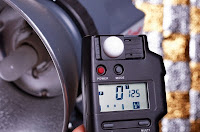 |
Incident Light Meter
(Image courtesy of Graeme Weatherston
at FreeDigitalPhotos.net) |
(a) CENTRE - WEIGHTED METERING MODE : When we use Centre - Weighted Metering mode, the camera, statistically, gives more importance or more emphasis or more weight on the middle / central area of the scene or the frame and meters the light from all the cells / zones of the middle / central area of the scene or the frame and then adjusts or averages all the light with the entire scene or the frame. So, in this type of metering mode, we get the middle / central part of the scene to be perfectly exposed & the rest part of the scene to be slightly balanced or averaged out. We can use Centre - Weighted Metering mode in those situations where our subject is in the middle or in the centre of the scene or the frame as well as while we have more light in the background, as in this metering mode, the camera gives more weight to the middle / central area of the scene or the frame and because of that our subject will be perfectly exposed. This type of metering mode is good for portraits as well as for close-up photography.
(b) MATRIX / EVALUATIVE METERING MODE : Matrix / Evaluative Metering mode works slightly similar to Centre - Weighted Metering mode as the camera divides the scene or the frame into different cells / zones & meters the light from all the cells / zones of the scene or the frame and then adjusts or averages all the lights with the entire scene or the frame, but, in this metering mode, it does not give any preference or importance or weight to any particular portion of the scene or the frame. This type of metering mode is not good for those situations where we have lots of light present behind our subject as, due to that bright light in background, our subject may look underexposed, so we can use this type of metering mode for landscape photography where it will collect all the lights from every portion of the scene or the frame and will give an average of all lights to make correct exposure.
(c) SPOT METERING MODE : Spot metering mode works slightly different from the other two types, as in this metering mode the camera meters light only from a small portion of the scene / frame, which may be either at the centre of the scene / frame or at the selected Autofocus (AF) point and ignores the rest of the scene / frame. This type of metering is good for portrait & macro photoraphy as we can give more emphasis or more weight on a specific area of the scene / frame by moving the spot from one Autofocus (AF) point to another.
No comments:
Post a Comment